“Nice shelves loaded with glass jars full of home-canned food, Erica! Now, don’t you live right on a fault line or something? Aren’t you guys in Seattle just waiting for an 8.0 earthquake to turn your whole city into rubble? What’s your plan for those jars of tomatoes, then, huh?”
Yes…I know, I know. There is a huge risk in investing time and money into jars of healthy home-canned food when one little Gaia Hiccup could topple your entire investment. Putting all your food in glass jars when glass is the thing most likely to be destroyed by the natural disaster that is most likely to hit you is not good planning.
If you want to go all the way in protecting your jars from tectonic rumbling, this is what it’s going to take:
Sturdy Shelving
Either wood or heavy duty metal. This is not the place for some snap-together plastic shelving unit designed to hold sweaters for nine months in a college dorm before falling apart. To quote my father, you want shelving, “strong enough that elephants can dance on it.”
The ideal shelves should be either attached directly to wall studs at the back and supported by legs at the front to distribute the weight or should be free-standing but secured to your home’s framing studs with heavy duty screws or earthquake strapping to prevent rocking or “hopping” of the entire shelving unit in a quake. We currently have wall-mounted, bracketed shelves, and this type of shelf can never really be as strong as a free-standing type.
Bracing at the Front of The Shelves
A good shelf means nothing if a jar can just bounce off of the front of it in a quake. People who build wood shelves can add 1×2″or similar strips of wood across the front of the shelf. Ideally, you want this bracing to be high enough to prevent a jar from bouncing right over it.
Here’s a nice example of wooden bracing at the front of the shelves. You can tell the owner of this pantry is serious because there are at least 32 5-gallon buckets full of what I presume to be dry goods like rice and wheat stored in this pantry.
If you buy Metro-type snap together wire shelving at industrial or kitchen supply places (and this stuff is a personal favorite of mine), they will come with a 3 or 4-inch high snap-in “backstands” for each shelf. They look like this:
The backstands are designed to stop items from falling off the back of the shelving units. However, if your unit is mounted securely against a wall and you clip the backstands in the front, you have excellent earthquake bracing for your jarred goods.
We have Metro-type shelving like this in the garage and I adore it. Our current shelving in the pantry is a rail-and-post system with medium-duty wire shelves. It looks good, but I suspect that before too much longer we will need to swap the medium-duty set up for industrial Metro-type shelving to handle the weight I’m putting on the shelves.
I have seen a lot of examples of bungee cords being used to brace jars against earthquakes and, frankly, I don’t know that it does much. Bungee cords are stretchy. I have a hard time believing that you could get a bungee cord tight enough to actually keep a jar from bouncing off a flat shelf in an earthquake. If anyone has any direct experience with this I’d love to know your experience.
Baby Locks on Cupboards (Even If You Don’t Have A Baby)
If you store items in cupboards that might be damaged in an earthquake should the doors bounce open (which they will), you can install inexpensive interior-mounted baby latches to your cupboards. These will help keep doors closed and jars and other items in, in the event of a quake.
Jar Padding
Once you’ve ensured your shelves aren’t going to collapse, and you jars aren’t going to rattle off your shelves, the final step in earthquake proofing the pantry is padding the individual jars.
The simplest way to do this is to store filled jars back in the original box they came in with the cardboard divider in place (or, make a sturdier DIY one out of corrugated cardboard). I highly recommend wrapping once or twice around your jar-boxes with duct tape when they are still new and crisp. This does a lot to keep them functional and strong enough to handle getting shoved around (gently, please) while full of preserves.
You can also wrap your jars individually in something squishy. If you get a package with a lot of bubble wrap in it, you can cut jar-sized sections and duct tape them into reusable bubble-wrap sized sleeves for your jars. My kids would have a field day with this.
If you are super handy you might even bee (get it? bee?) able to crochet something like this lovely jar cover, although making 27 or 48 dozen of them might get seriously time prohibitive:
The simpler, uglier equivalent to apiary-themed jar garments is to re-purpose your old worn out tube socks by cutting off the top stretchy bit and sliding that on to protect your jars.
My Half-Ass Solution
I don’t have a perfect solution for my own pantry, but I have come up with a kinda half-ass solution that may or may-not accomplish anything. But it was free, and it makes me feel slightly better.
This is what my pantry shelves look like up close. The medium-duty wire shelf snaps into the wall-mounted bracket. These types of shelving systems are great and really customizable for closets and are probably great for pantries too, if the owner of the pantry is not insane about storing heavy canned goods, like me. You can get shelving systems like this at any organization store or big-box home improvement chain.
Note the rolled-over lip at the front of the shelf. I turned a few upside down and got this.
Here’s the same shelf, side-by-side, flipped upside down and right-way-up. (Sorry about the crappy not-quite-Instamatic photos. The natural light in my pantry is deliberately non existent.)
Simply flipping the wire shelves gives my jars a teeny bit of protection against sliding right off the front. The lip generated by this move is about 3/4″ deep. That’s not a lot but it is something.
That lip provides a measure of protection in that it slows down the daily earthquake that is my 2 year old son. He likes to run into the pantry in an attempt to play “stack the jars into a tower!” This is one of my least favorite games and I think he just likes seeing how fast I can run after him squealing, “Noooooo!”
I can’t say that it would stop the jars from bouncing right off the shelf in a big quake, but I think it might help in a small tremor.
Baby steps.
Have you done anything to protect your preserves from an earthquake or other natural disaster?
Preparedness means a lot of different things depending on your outlook and goals. But some things you can never be prepared for. Today we remember the victims of the 9/11 bombings and those first responders who were charged with being prepared for anything, no matter how terrible, and who did never faltered in their oaths on that day.
22
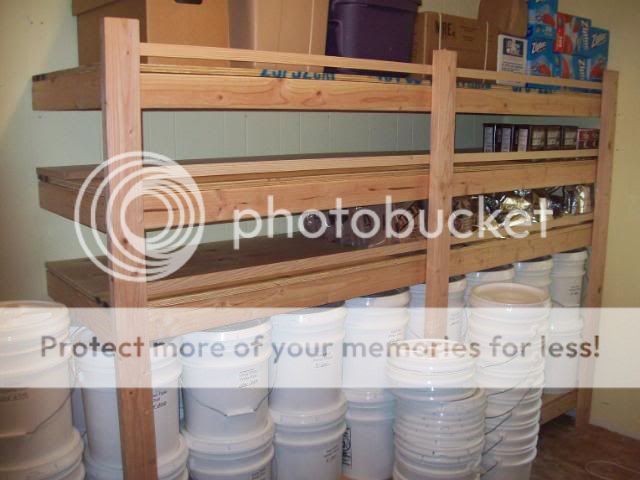



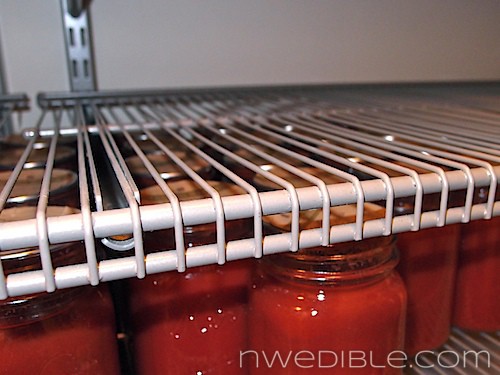
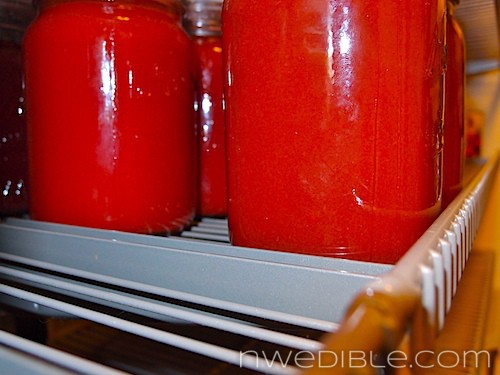
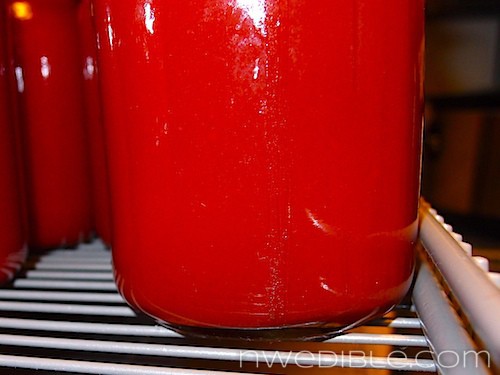
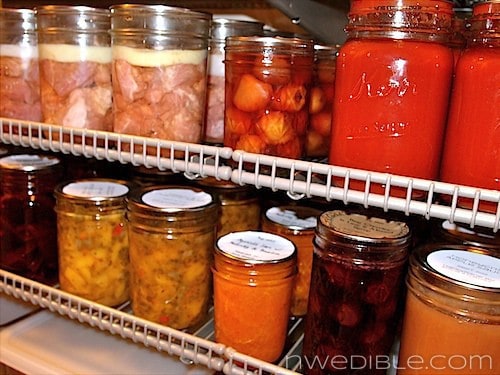
My original pantry shelves were the California-Closet type that attached to the wall. I say “original” because one day the whole thing ripped itself off the wall anchors and dumped everything on the hardwood floor. They were fully loaded, of course. Amazingly, I only lost one jar (mint jelly). The pantry doors, though opened by the force of all that weight, helped break the jars’ fall. Those jars are pretty strong! I now have Ikea stand-alone shelves in the kitchen (metal shelving in the garage “pantry”). Still not earthquake proof, but much more able to handle the load.
We’re in the same region, so it’s something I’ve thought about. We have the metal Costco shelves, and I just put the canned goods as close to the bottom as possible. Which doesn’t seem like much, but considering I used to have them at the TOP of the shelves, I count it as earthquake prep.
Before and after of the food pantry: http://beingfrugalbychoice.blogspot.com/2011/11/taking-winter-by-storm-part-ii-food.html
Rubber bands on the jars are also a great to keep them from knocking together. The thick ones that come on vegetables at the store are perfect.
Living in earthquake central here in the Bay Area means we’re fairly prepared. The shelves aren’t going to last a whole lot longer, due to the weight of the jars, and when they go, I’m going to build wooden ones. Until then, things are stored in boxes mostly. I could always be better about organization and safety. But we do have an earthquake kit set up, which probably needs the food rotated.
I’m thinking that paper to-go hot cup sleeves might be a good way to pad smaller individual jars. See if your local coffee shop would save up old ones, or gather them from friends and coworkers to supplement any you may pick up on your own. Also, a lot of restaurant cash and carry shops will have them by the case, Costco and similar stores may have them too. The ones my cafe picks up are recycled paper and you just pop them open and side them on the cup.
Put your full jars back in the boxes they came in, and store on the floor. Unless something heavy falls on the boxes, they should be able to slide all over the place without getting broken. I wonder about dehydrating and using those vacuum storage bags. Not breakable and easier to take with you in an evacuation situation.
I don’t have that much floor. 😉
I’ve always just put my jars back in the divided boxes they came in, but it never occurred to me that this could help protect them. I was just too lazy to figure out anywhere else to put them, and it makes me happy to see neatly stacked boxes in my shelving units.
Haven’t done a thing. I am going by the fact that the chance of an earthquake here is very very slim. Though my canned goods are in cupboards that latch and the doors are up to the shelves. As long as the last person to open that cupboard has reclosed it I think they would jumble, but not fall any real distance. I did google earthquake history here and it seems we have felt tremors from quakes centered really far away, maybe 3-4 times last 125 years. It also says we feel earthquakes that come from IL and OH due to the New Madrid fault, like 15 times or so. None have been destructive.
I still have lots of my old canning jar boxes. They were nicer, with full box flaps. The new cardboard trays they come in are not much. My old boxes even have that extra space to store rings and lids.
We are quite prepared I think. If you can remember back to Y2K I thought for sure the world would crash and we would be in the dark ages for at least a month and maybe longer. And I figured we’d have to take in my mother and probably another family. So I spent a year stocking up on food in cans that would just need heating like soup ( my family can’t stand canned soup but I figured I wasn’t going to be cooking lots of from scratch bean soups ) etc., canned beans, canned fruit, powdered milk, ramen. Well we all know nothing happened so I think I had enough toilet paper for the next 2 years. I gave the canned soup to the food drives.
I think my husband was kind of disappointed. He was looking forward to cooking out over the campfire, though I am sure the novelty of that would have worn off very quickly.
I live near St Louis in Illinois. Yea ive been kinda worrying about New Madrid and worst case scenarios. Something obviously is going on here.
http://earthquake.usgs.gov/earthquakes/map/
Interesting interactive map there. I didn’t realize there were all those earthquakes in Costa Rica on 9-5 until someone mentioned it in the NEL FB comment. I always thought we were kind of protected here by the Niagara Escarpment, though I may be wrong.
I’ve never observed a pantry after an earthquake so I can’t speak much for glass jars, but I can tell you that from a structural point of view, the biggest concern would be how shelves holding jars are likely to collapse. Shelves are designed to take vertical forces. But the horizontal forces generated in an earthquake would cause a set of shelves to collapse to the side. (Imagine that the wall would push your shelves over in a sliding-like manner.) In an old, not earthquake-designed, multifloor building (let’s image it functions a lot like a shelf in an earthquake), you would retrofit the building by anchoring diagonal bracing from the top left of the shelf unit to the bottom right. And then you would run that bracing the opposite direction on the opposite side. Not sure that makes sense. In theory, those diagonal braces absorb the extra horizontal force and keep the building – or shelves – from collapsing sideways. Most likely, you can observe this technique all over Seattle in the building design. I’m also not sure it will work for shelves in a pantry, but it might be another step you could try.
Simply attaching a small cable from the post to post to post (where you would put the wood strips) about 3 inches up from the bottom of each shelf will hold the cans. They make cables covered in a clear rubbery material that would be just perfect for this application. You can get these at any big box home improvement store.
I reuse the mesh sleeves that I get at the wine store when I buy more than one bottle of wine to store my canning jars. Just Google mesh bottle sleeves for multiple websites to purchase them.
has anyone tried these? my husband saw them at the Self Reliance Expo in Hickory, NC this weekend.
http://www.mypatriotsupply.com/Quart_Size_Jarbox_p/z_jarboxqt.htm
$25 to store 12 quart jars. I certainly couldn’t afford to buy enough of those to store all my jars in. Nice idea if one has lots of extra money.
Your old hole-y socks would also be great to protect your jars…just cut the toes off, or not. 😉
If you don’t want to buy the backstands for the Metro (and Metro-like) shelving, the shelves can be put on the poles upside down so that the lip goes up. We have done this with several of our shelves and it works great for keeping things on the shelves.
I hadn’t even thought about protecting my jams. Top of my mind is preventing the huge awful sticky mess if they smash. I wonder if a thick rubber band around each jar would help cushion them a bit? because if that worked, it would be quite affordable.
I’m going to link your page here to a post I’m doing about earthquake-proofing a kitchen, hope that’s okay! I love your photos- don’t apologize for them!! (: They make me hungry…!
For quake-proofing my shelves (which is a must living so close to SF), my husband tied nylon cording to the back left post, wrapped it around to the front left post, and wrapped it in such a way that the cord’s friction on itself keeps it tight. it was easy to tighten until the cord made a thrumming sound (nearly like a guitar)… he proceeded to wrap it all the way around, and then around the front again at a higher level. I now have two rows of nylon cording wrapped very tightly around my shelves, and the shelves are anchored against the wall. If you’d like pictures, I can send one to you, I know I do not describe things well.
And today we discovered that it does, indeed, work! We had a small quake here, and funny enough, it was while reading THIS article.
Pictures please
The problem with turning wire shelves upside down is that a good earthquake can still bounce the jars up and down. That movement can cause the welding/soldering that holds the shelf wires to the bracing to break, causing all those jars to fall on top of whatever is below them. Happened to a friend of mine who thought she was being smart!